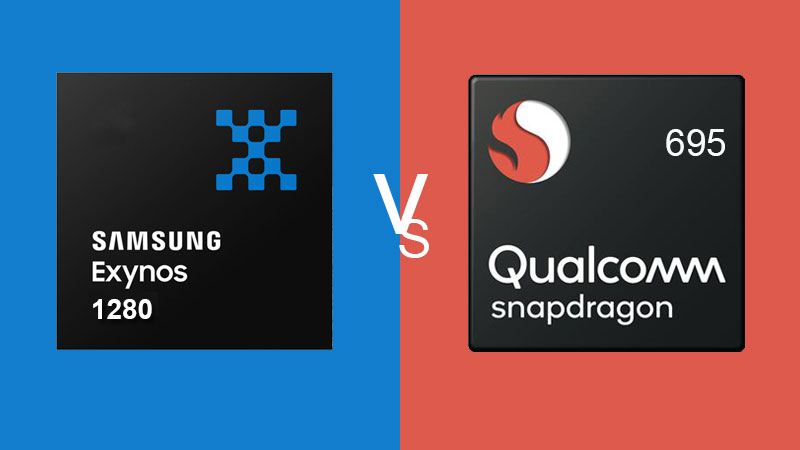Samsung’s Exynos 1280 and Qualcomm’s Snapdragon 695 are two prominent players. The battle for supremacy extends beyond flagship devices. The midrange segment has become a stream of innovation, with Samsung’s Exynos 1280 and Qualcomm’s Snapdragon 695 emerging as contenders competing for the spotlight. Let us dive into the details to understand their strengths, weaknesses, and how they stack up against each other.
Design and Architecture
Samsung Exynos 1280, born from Samsung’s innovation, boasts a 5nm manufacturing process, a testament to the industry’s pursuit of efficiency. Its CPU configuration integrates a performance cluster with two ARM Cortex-A78 cores, blazing at 2.4 GHz, alongside an efficiency cluster hosting six ARM Cortex-A55 cores clocked at 2 GHz. This strategic combination aims to deliver a balance of power and battery efficiency.
Qualcomm’s Snapdragon 695, built on a 6nm process, introduces a powerful combination of Kryo 660 CPU cores. The fast cluster boasts two ARM Cortex-A78 cores clocked at 2.2 GHz, while the power-efficient cluster houses ARM Cortex-A55 cores at 1.7 GHz. This architecture aims to deliver performance without compromising on battery life.
Graphics and Display
The Exynos 1280 supports displays up to 1080p with a refresh rate of 120Hz and is equipped with an ARM Mali G68 MC4 GPU. This caters to a seamless visual experience, complemented by an Image Signal Processor (ISP) capable of handling cameras with resolutions up to a staggering 108 MPixels.
Featuring an Adreno 619 GPU, the Snapdragon 695 supports vibrant displays and efficient graphics processing. However, it falls short compared to the Exynos 1280, capping display support at 1080p.
Connectivity and Modem
A standout feature is its integrated 5G modem, supporting Sub-6GHz and mmWave spectrums, ensuring fast data speeds. Additionally, LTE Cat 18 ensures a reliable connection. However, it caps its Wi-Fi capability at the fifth generation (Wi-Fi 5) and Bluetooth 5.2.
The Snapdragon 695 impresses with its X51 5G radio, reaching download speeds of up to 2.5 Gbps. While lacking mmWave support, it compensates with robust 4G capabilities. Its connectivity suite includes Wi-Fi 5 and Bluetooth 5.2, catering to the essentials of a connected lifestyle.
Benchmark Results
AnTuTu 10: The Exynos 1280 outshines the Snapdragon 695 in AnTuTu benchmarks, showcasing a slight performance advantage across various scenarios.
GeekBench 6: While the Snapdragon 695 leads in single-core and multi-core scores according to GeekBench 6, the Exynos 1280 remains competitive, offering users a smooth and responsive experience.
NanoReview scores and benchmark results suggest that both SoCs are evenly matched in terms of overall chip performance, with each having its strengths in different areas.
Performance
| Aspect | Exynos 1280 | Snapdragon 695 |
|---|---|---|
| Manufacturing Process | 5nm | 6nm |
| CPU Configuration | 2x Cortex-A78 cores at 2.4 GHz + 6x Cortex-A55 cores at 2 GHz | 2x Cortex-A78 cores at 2.2 GHz + Cortex-A55 cores at 1.7 GHz |
| GPU | ARM Mali G68 MC4 | Adreno 619 |
| Display Support | Up to 1080p, 120Hz refresh rate | Up to 1080p |
| Camera Support | Up to 108 MPixels | Single Camera: Up to 108 MP; Single Camera (MFNR, ZSL, 30 fps): Up to 32 MP |
| Connectivity | Integrated 5G modem (Sub-6GHz, mmWave), LTE Cat 18, Wi-Fi 5, Bluetooth 5.2 | X51 5G radio (up to 2.5 Gbps download), 4G capabilities, Wi-Fi 5, Bluetooth 5.2 |
| Gaming Performance | Slightly better with a score of 26 | Score of 24, suggesting a slightly less smooth gaming experience |
| Everyday Usage | Responsive for web browsing, social media, and multimedia consumption | Responsive for everyday tasks, choice depends on individual preferences |
This tabulation summarizes the key performance metrics of the Exynos 1280 and Snapdragon 695, highlighting their respective strengths in CPU performance, gaming experience, and battery life efficiency.
FAQ’s
Which SoC is more suitable for everyday usage?
For everyday tasks such as web browsing, social media, and multimedia consumption, both the Exynos 1280 and Snapdragon 695 provide responsive performance and seamless user experiences. The choice ultimately depends on individual preferences and priorities.
Bottom Up
In this showdown between the Exynos 1280 and Snapdragon 695, both SoCs bring impressive features to the table. The Exynos 1280 excels in camera capabilities and gaming performance, while the Snapdragon 695 boasts superior battery efficiency. Choosing between the two depends on your priorities – whether it’s capturing stunning visuals or ensuring your device lasts throughout the day. As midrange contenders, these chips prove that high-performance features are no longer exclusive to flagship devices, providing users with compelling options in the competitive world of smartphones.

